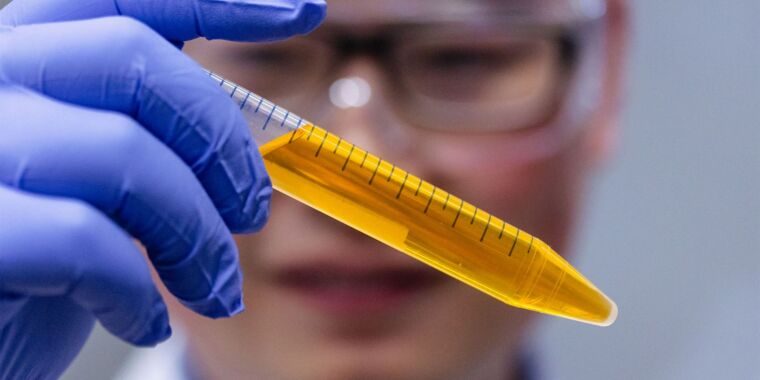One of the key challenges in medical imaging is penetrating opaque skin and other tissues to see internal organs and structures – this is where ultrasound, magnetic resonance, x-rays, etc. come in. There are chemical cleaners that can make tissue transparent, such as acrylamide and tetrahydrofuran, but they are rarely used in vivo because they are highly toxic or can dissolve important biomolecules.
But now, a team of scientists at Stanford University has finally found a substance that can reversibly make skin transparent without damaging it: tartrazine, a popular yellow-orange food coloring called FD&C Yellow 5, which is often used to color Doritos.
Playing with light
You can’t see through skin because it’s a complex tissue made up of the interior of cells and other fluids, as well as aqueous components like proteins and lipids. The refractive index is a measure of how much (on average, of course) light slows down when passing through a substance compared to passing through a vacuum. These aqueous components have a low refractive index, while proteins and lipids have a high refractive index. As a result, light passing through skin is constantly bending as it endlessly passes through the boundaries between materials with higher and lower refractive indices.
This causes the light to scatter, and once it penetrates the skin, it never comes back out again. All we see is the light that reflects off the surface of the skin. The trick to making things transparent is mainly to have a uniform refractive index, so that light, or at least parts of the spectrum, aren’t constantly bending and scattering. That’s where the dye in Doritos comes in.
“What’s most surprising about this study is that dye molecules are typically expected to reduce transparency,” says Guosong Hong, an assistant professor of materials science and engineering at Stanford and senior author on the paper. “For example, if you mix blue pen ink with water, the more ink you add, the less light will pass through the water. But in our experiments, when we dissolved tartrazine in opaque materials that normally scatter light, like muscle and skin, the more tartrazine we added, the more transparent the material became. This is the opposite of what is typically expected for dyes.”
Transparency Lotion
Hong’s team simply dissolved the dye in an aqueous solution, creating a kind of lotion that induced transparency. It worked because the dye reduced the difference in refractive index between water and lipids in the skin. The team then gently rubbed it into a polymer gel, mimicking the light-scattering properties of tissue. From there, they moved on to thinly sliced chicken breasts and live mice.
This “transparency lotion” began to work within just a few minutes of being applied to the skin of mice. When massaged into a shaved scalp, scientists were able to observe the brain’s blood vessels using laser speckle contrast imaging – a technique that normally only works if the scalp is removed. When applied to the abdomen of the mice, all of the internal organs, including the liver, bladder and small intestine, became visible to the naked eye. All that was needed to reverse the effect and make the skin opaque again was to wash the lotion off with water.
However, there were some problems. First, Tartrazine absorbs most of the light at wavelengths around 257 and 428 nanometers, causing us to see purple and blue hues, while above 600 nanometers, absorption is minimal, causing transparent skin to stain everything red. The second problem was the depth of penetration; the lotion was only effective in areas with thin skin, but did not penetrate well into thicker skin.
Finally, the formula wasn’t universal: It relied on finding chemicals that matched the refractive index of lipids when dissolved in water, and the lotion’s exact composition was determined by trial and error. With so much variability from mouse to mouse, it can be hard to find a solution that works for everyone.
Tattoo and needle
The problem of penetrating deep into thick skin was partially solved by making application a little less painful. “Using a microneedle patch applicator or subcutaneous injections may help deliver the molecules to the thicker layers of skin,” Hong explained. The redness issue, he suggested, could be addressed by testing different dyes. “My lab is currently focusing on identifying molecules with sharp absorption in the near-UV range and minimal tailing of the spectrum into the visible range to ensure tissue transparency without redness,” Hong said.
“This research has only been done on animals. However, if the same technology could be applied to humans, it could have a variety of benefits in biology, diagnostics, and even cosmetics,” Hong suggests. Some of the benefits he sees include being able to evaluate deep tumors without relying on biopsies, reducing the burden of blood tests by making veins easier to locate, and even improving the accuracy of laser tattoo removal by being able to precisely target pigments under the skin.
But there’s bad news: Although FD&C Yellow 5 dye is widely available, trying to replicate Hong’s results at home and make your own clear lotion might not be a good idea. “The human toxicity of the dye molecule, especially when applied topically, has not been fully evaluated, so we strongly discourage attempting this on human skin,” Hong says.
And it may end up being ineffective: “Human skin is much thicker than mouse skin, and the stratum corneum, the outermost layer of the epidermis, acts as a significant barrier preventing molecules from being effectively delivered to the dermis,” Hong explains.
Science, 2024. DOI: 10.1126/science.adm6869

